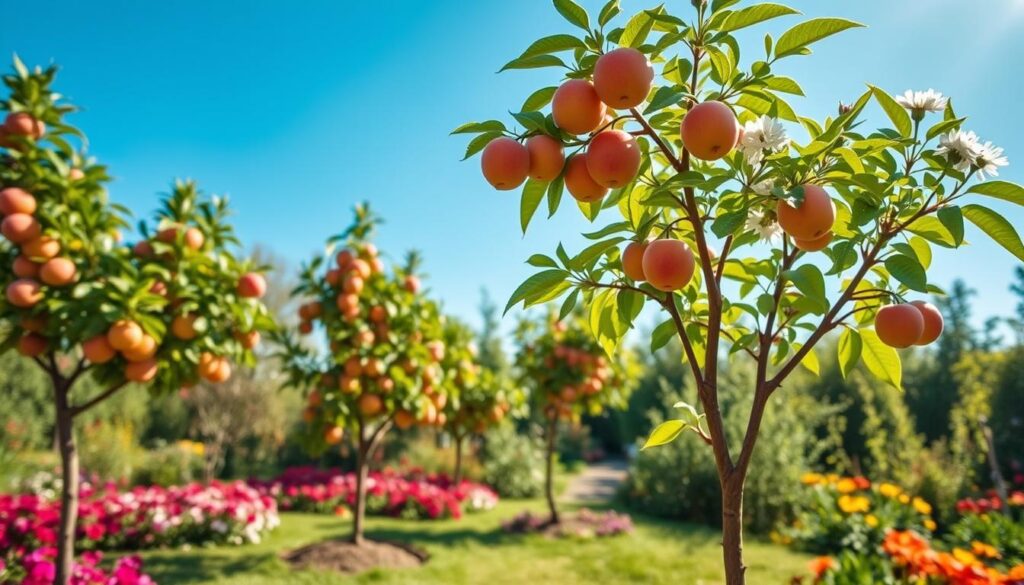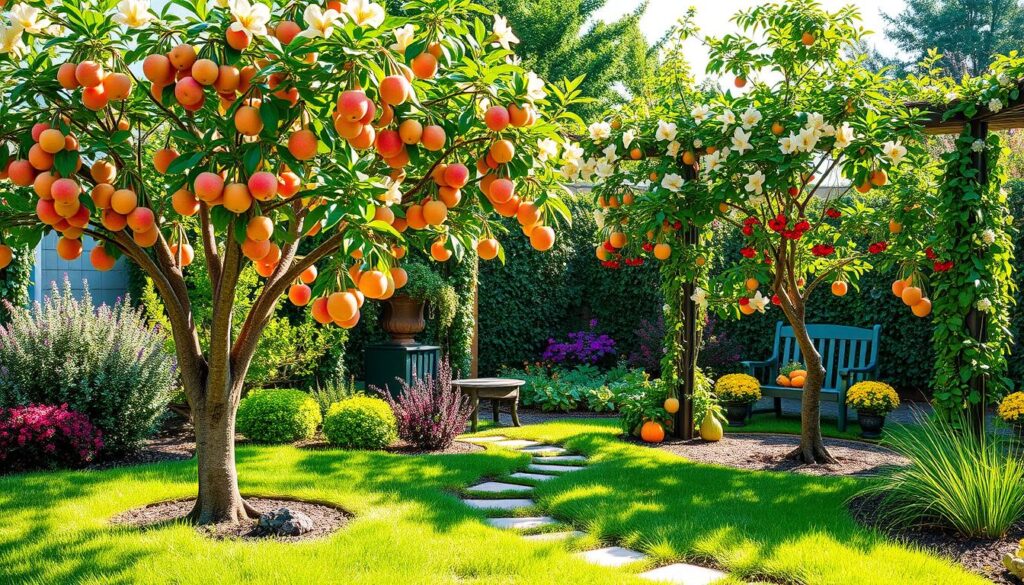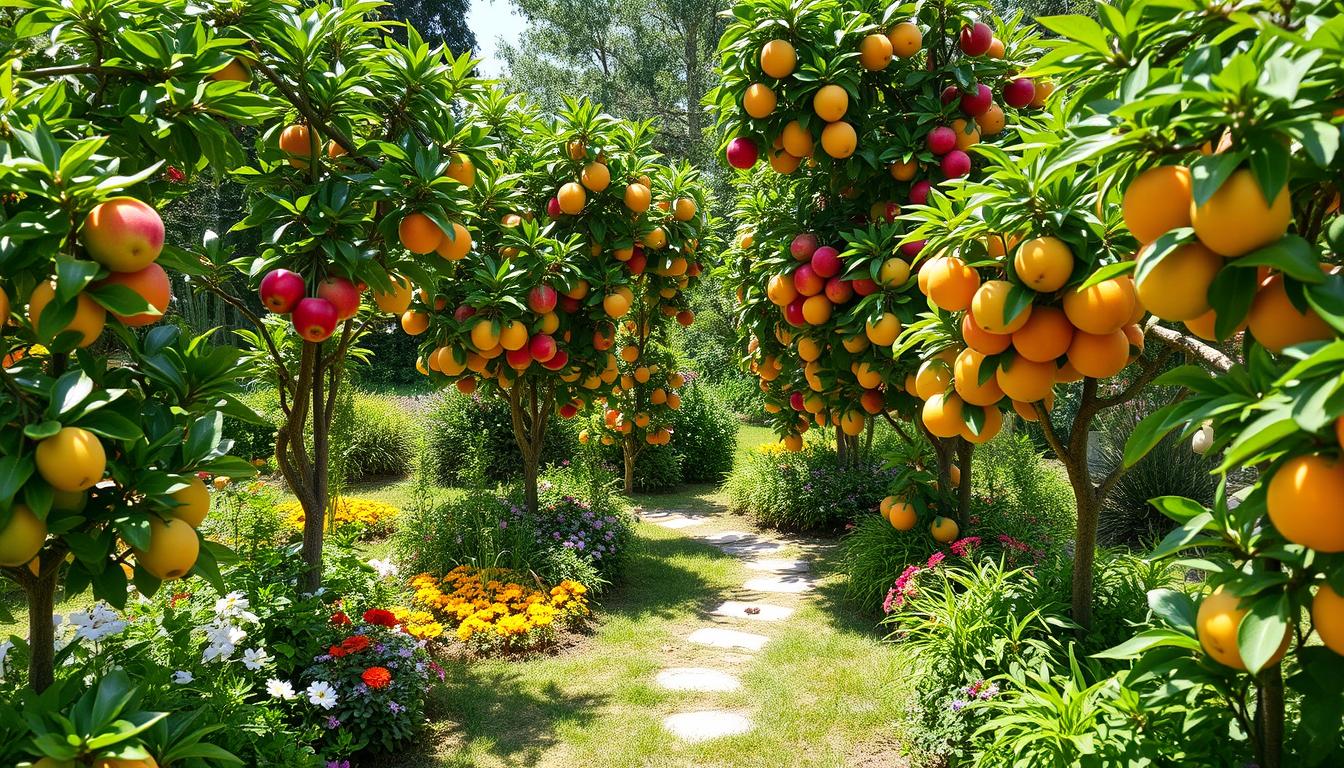Dwarf fruit trees are great for those with little space but still want a fruitful garden. In this article, we’ll look at the Top 7 Dwarf Fruit Trees for Small Gardens. These compact trees add beauty and productivity to small spaces. They let city gardeners enjoy fresh fruits on patios, decks, or balconies without taking up too much room.
Some dwarf trees, like the dwarf apple tree, only grow 8 to 10 feet tall. Others, like the dwarf peach tree, average 10 feet. These trees offer a big harvest without needing a big yard.
As we explore these small garden fruit trees, you’ll see why they’re so popular. We’ll cover their care needs and which ones are best for different growing zones. This guide will help you pick the perfect tree for your space, making your small garden a fruitful delight.
Key Takeaways
- Dwarf fruit trees are perfect for small gardens, making the most of space and providing lots of fruit.
- They usually grow between 3 to 10 feet tall, making them easy to care for.
- Self-pollinating varieties can do well even without another tree nearby.
- Dwarf trees come in many types, including apples, pears, peaches, and cherries.
- They’re great for city gardens, adding beauty and function.
Introduction to Dwarf Fruit Trees
Dwarf fruit trees are great for those with little gardening space. They grow well in tight spots where big trees can’t fit. These trees usually grow between 3 to 10 feet tall, perfect for small gardens or patios.
They not only save space but also look beautiful. Their leaves and flowers add to the garden’s beauty. This makes them a great choice for small areas, without losing out on fruit.
With proper care, growing your own fruit is rewarding. Trees like the ‘Cameron Select’ dwarf apple and the ‘Belle of Georgia’ dwarf peach are great options. They let me enjoy gardening, even with limited space.
Benefits of Growing Dwarf Fruit Trees
Dwarf fruit trees are great for small yards. They grow compactly, making the most of limited space. This means I can enjoy a bountiful harvest with less effort.
Space Efficiency in Small Yards
Dwarf fruit trees usually don’t grow taller than ten feet. Some are as small as two or three feet. This makes them perfect for small gardens or balconies.
They fit well in tight spaces, allowing me to use my garden creatively. This way, I can grow beautiful and fruitful plants.
Ease of Care and Maintenance
Dwarf fruit trees are easier to care for than larger trees. They need regular watering, pruning, and feeding to thrive. Their hardiness makes them great for container gardening.
They have a shorter lifespan of 15-20 years. This means I can enjoy a productive garden without a long-term commitment.
Rapid Fruit Production
Dwarf fruit trees start producing fruit quickly. They can be ready to harvest in just one or two years. Some varieties can even produce up to 70 apples or 50 lemons annually.
This fast fruit production makes them a popular choice. They offer a quick way to enjoy homegrown fruits without waiting years.
| Feature | Dwarf Fruit Trees | Full-size Fruit Trees |
|---|---|---|
| Height | 2-10 feet | 15-30 feet |
| Years to Maturity | 1-2 years | 3-5 years |
| Average Lifespan | 15-20 years | 35-45 years |
| Fruit Yield | 50-70 apples, 50 lemons | Higher yield due to size |
| Space Requirements | Minimal | Large area needed |
Top 7 Dwarf Fruit Trees Perfect for Small Gardens
Choosing the right fruit trees for small gardens can make gardening more enjoyable. Dwarf fruit trees save space and give a lot of fruit. Let’s look at three great options for the best dwarf fruit trees.
Dwarf Apple Trees
Dwarf apple trees are great for small spaces. They don’t need another tree to pollinate, making them easy to care for. The Espalier Grafted Apple Tree is especially useful because it can grow different types of apples on one tree.
Dwarf Pear Trees
Dwarf pear trees are a smart pick for small areas. They grow well in tight spaces and give tasty fruit. Their beautiful flowers also make them a nice addition to any garden.
Dwarf Peach Trees
Dwarf peach trees, like the Bonfire Patio Peach Tree, are perfect for small gardens. They grow 4-6 feet tall and 5-8 feet wide. They give delicious peaches and grow well in containers, making them easy to move around.
If you’re new to gardening, GardenBeginner.com is a great place to start. It has lots of tips for beginners. By picking the top 7 dwarf fruit trees, you can enjoy fresh fruits and make the most of your small space.
Best Dwarf Fruit Tree Varieties
Choosing the right dwarf fruit tree varieties can make my garden more productive and beautiful. Knowing the best options helps me use space wisely and enjoy different fruits. Here are some top picks, focusing on dwarf apple varieties, nectarines, and peaches.
Popular Dwarf Apple Varieties
Dwarf apple trees grow up to 10 feet tall, perfect for small gardens. They don’t need another tree for pollination, making them easy to care for. Some popular types include:
- Honeycrisp – Known for its sweet, crisp taste.
- Fuji – Offers a mix of sweetness and tartness.
- Granny Smith – Great for baking with its tart flavor.
These trees do well in certain USDA zones. With enough sunlight and care, they can produce lots of apples even in small areas.
Nectarine and Peach Options
Dwarf peach trees also fit well in my garden, reaching about 10 feet tall. Grafted dwarf peach trees are especially popular. They produce tasty fruits and grow well in many USDA zones. Some top varieties are:
- Elberta – A classic, sweet peach.
- Suncrest – Known for its juicy, flavorful flesh.
Nectarine trees are another great choice, growing similarly to peaches. Adding these trees to my garden adds diversity and beauty. It’s important to know their needs, like sunlight and water, for them to grow well.
If I have questions or need help choosing, I can contact for support. Getting expert advice ensures my garden will be fruitful. With the right choices, these trees will thrive and give me delicious fruits every year.
| Fruit Tree Type | Height (Feet) | Zones | Self-Fertile |
|---|---|---|---|
| Dwarf Apple | Up to 10 | 3-8 | Yes |
| Dwarf Peach | Up to 10 | 4-9 | Yes |
| Dwarf Nectarine | Up to 10 | 4-9 | Yes |
Growing Conditions for Dwarf Fruit Trees
To grow small garden fruit trees well, you need to know their needs. Each type of dwarf fruit tree has its own requirements for the best growth and fruit. Here are the key factors that affect their health and fruit production.
Sunlight and Water Requirements
Dwarf fruit trees love full sunlight, needing at least six hours of direct sun each day. Without enough light, they can’t photosynthesize well, leading to less fruit. They also need well-drained soil that stays moist. In dry times, I make sure they get enough water to stay healthy.
Soil Preferences
Dwarf fruit trees do best in soil that drains well and has a slightly acidic to neutral pH (around 6.0 to 7.0). Sandy loam is perfect for their roots, helping them get the nutrients they need. Adding organic matter improves the soil, helping the trees grow stronger and produce more fruit.
Container Gardening Versatility
Container gardening is great for growing dwarf fruit trees when space is tight. I use special pots for fruit trees, making sure they have enough room for their roots. It’s important to water them regularly and check the soil moisture. Also, dwarf trees in containers need staking to stay upright, especially those on less dwarfing rootstocks.
Self-Pollinating Dwarf Fruit Trees
Self-pollinating dwarf fruit trees are perfect for small gardens. They don’t need another tree to produce fruit. This makes them great for tiny spaces or growing in containers.
Importance of Self-Pollination
These trees are easy to care for. They often need less work and can grow well on their own. For example, the Golden Delicious Apple Tree and the TruGold™ Peach Tree grow well without another tree nearby.
Varieties You Can Grow Alone
Some top dwarf fruit trees don’t need cross-pollination. Here are some:
- Dwarf apple trees: Granny Smith, Anna, and Dorsett Golden
- Dwarf peach trees: Flat Wonderful™, Contender, and Elberta
- Dwarf persimmon trees: Known for their smaller yet delicious fruit
- Dwarf berry bushes: Excellent choices for small spaces and cold hardiness
The Reachables® Dwarf Fruit Trees are special. They grow full-sized fruits on small trees. This saves space and makes care easier. Choosing self-pollinating trees helps you get more fruit with less work. Always check with customer service about self-pollination before buying online.

| Tree Variety | Pollination Type | Notes |
|---|---|---|
| Golden Delicious Apple Tree | Self-Pollinating | Sweet flavor, ideal for containers |
| Granny Smith Apple Tree | Self-Pollinating | Tart taste, excellent for baking |
| TruGold™ Peach Tree | Self-Pollinating | Fruits quickly, excellent taste |
| Flat Wonderful™ Peach Tree | Self-Pollinating | Smooth skin, great for fresh eating |
| Dwarf Persimmon Trees | Self-Pollinating | Sweet, small fruit rich in flavor |
There are many self-pollinating dwarf fruit trees to choose from. Growing a compact garden with these trees is a fun and rewarding experience.
Compact Fruit Trees for Urban Gardens
Urban gardening can be tough because of small spaces. But, compact fruit trees are a great solution. They grow well in tight spots and give lots of fruit. Adding them to urban gardens boosts both productivity and beauty.
Suitability for Small Spaces
Many compact fruit trees fit well in small areas. Dwarf apple trees, for example, grow to 10 to 15 feet tall and 10 feet wide. They work well in many garden setups.
The Key Lime tree is perfect for zones 9 and 10. It grows to 8 to 10 feet tall and 5 to 6 feet wide. This size makes it great for patios or balconies.
Enhancing Urban Landscapes
Compact fruit trees are not just practical for small spaces. They also make urban areas greener and more colorful. Trees like Meyer Lemon and Celeste Fig add beauty and give fresh fruit.
These trees do well in cities, making them a great choice. For extra beauty, consider the Majestic Beauty® Fruitless Olive and Timeless Beauty® Desert Willow. They’re perfect for any urban garden.
| Type of Tree | Mature Size (Height x Width) | Hardiness Zones | Notes |
|---|---|---|---|
| Dwarf Apple Tree | 10-15 ft x 10 ft | 4-8 | Produces different apple types; quick yield. |
| Key Lime Tree | 8-10 ft x 5-6 ft | 9-10 | Thrives in pots; ideal for small spaces. |
| Meyer Lemon Tree | 6-8 ft x 4-5 ft | 8-10 | Produces fruit indoors as well. |
| Celeste Fig Tree | 5-10 ft x 5-10 ft | 7-10 | Good for indoor growth. |
| Majestic Beauty® Fruitless Olive | Up to 25 ft | Varies | Ornamental; non-fruiting. |
| Timeless Beauty® Desert Willow | 15-20 ft | Varies | Ornamental; adds beauty to the landscape. |
How to Care for Dwarf Fruit Trees
Keeping dwarf fruit trees healthy is key, especially in small gardens. Knowing how to care for them can boost fruit yield and tree health. I’ll share tips on pruning, fertilizing, and managing pests and diseases.
Pruning Techniques
Pruning is vital for dwarf fruit trees. It promotes growth, improves air flow, and lets in more sunlight. Here are some tips:
- Prune in late winter or early spring, before new growth begins.
- Remove dead, damaged, or crossing branches for healthy growth.
- Shape the tree to keep it open, which helps with air and light.
Fertilizing Best Practices
Good fertilization is crucial for growth and fruit. Organic fertilizers are best for soil health. Here’s how to fertilize:
- Use fertilizers made for fruit trees, focusing on potassium and phosphorus.
- Apply mulch from compost or pine shavings to improve soil and keep it moist.
- Check soil pH and nutrient levels often to adjust fertilization.
Pest and Disease Management
Keeping pests and diseases away is important. Polyculture planting helps orchards stay healthy. Here are some strategies:
- Plant companion plants like chives and lavender to repel pests and attract good bugs.
- Regularly check for disease or pests to catch them early.
- Use organic pesticides or natural solutions for tough problems.
Using Dwarf Fruit Trees in Landscape Design
Dwarf fruit trees are great for making your garden look better. They fit well in small yards and add beauty and function. By adding these trees, you can make your garden both pretty and useful.
Creating Visual Interest
Dwarf fruit trees can be a beautiful centerpiece in your garden. Their small size lets you arrange them in creative ways. For example, you can line up dwarf cherry trees with blueberry shrubs for a colorful and fruitful look.
Combination with Other Plants
Dwarf fruit trees do well with other plants, making your garden more interesting. Adding herbs or flowers not only looks good but also attracts bees and butterflies. Plants like chives or marigolds help the trees grow strong. For more ideas, check out guides on planting fruit trees in small yards.

Conclusion
Dwarf fruit trees are perfect for those who want to enjoy gardening in small spaces. They are easy to care for and fit well in tiny gardens. These trees, like apples and guavas, not only look good but also grow fruit quickly.
Looking for the best dwarf fruit trees? Try growing lemons, peaches, or blackberries in containers. They do well in five-gallon buckets and can be moved if needed. It’s a great way to garden without much work.
Want to know more about gardening and privacy? Check out this privacy policy for useful tips. Growing dwarf fruit trees is a green way to garden. It makes our homes and communities healthier with fresh food.



Leave a Reply